|
|
|
|
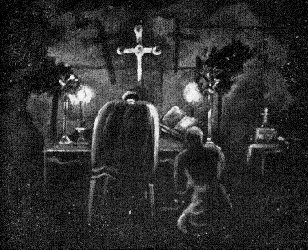
|
|
Church of England Service in the courtyard of Changi Gaol
|
|
by Charles Thrale
|
|
The above painting shows Padre Young of Kirk Deighton. Leeds, carrying out a service in one of the courtyards of Changi Gaol, “Please God set us free”
|
|
|
|

|
|
|
|
ST. George’s Church, India Lines
(Mark I)
Chaplain - Rev. E. W. B. Cordingly., C.F
Taken from his Diary
Originally a mosque and converted into a Church by 18th Div. R.E's. By taking in the verandahs seating accommodation was 600. Opened on first Sunday after capitulation and was throughout its existence the centre of a deep spiritual life and tremendous activity.
|
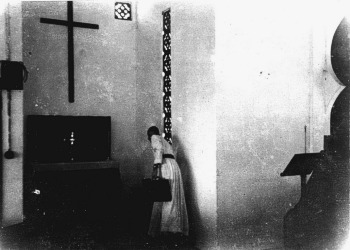
|
|
Pictures taken of St Georges
|
|
by Harry Stogden
|
|
The Sapper and Ordnance Workshops produced materials, and the Church was soon lavishly furnished. The English Altar had four wrought iron riddel posts with curtains made from a torn marquee. The verandahs was a painted and carved plaque of St. George and the Dragon.
The Altar Cross was made from a 4.5 howitzer shell and gun parts engraved with the badges of the Regiments and Corps in the area. The Priests' stall had a large carved panel of the badge of the Royal Army Chaplain's Dept. Lighting and Hood-lighting were possible by tapping batteries from broken lorries. '
On July 20th, 1942, the Bishop of Singapore confirmed 179 officers and men in St. George's, followed by an Ordination Service of a Deacon, and at the Communion Service which followed Holy Communion was received by a Christian Japanese officer, an Indian Canon from the Cathedral, a Dutch General from Java, as well as British and Australian officers and men.
Holy Communion, Mattins and Evensong held daily and the Church was in constant use from dawn to " Lights out."
Closed down April 1943 when area was evacuated but all furniture not taken to Thailand removed and used in Churches built later in other areas.
Communicants, over 15,000.
|
|
|
|
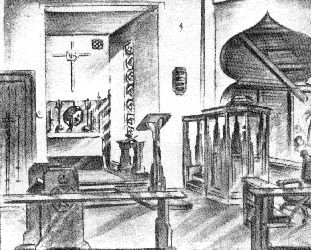
|
|
Converted Mosque
|
|
By Charles Thrale
|
|
This was thought to be the only mosque in the world ever used by the Church of England.
The above painting shows the inside of the Mosque after the convertion. All the furniture and fittings were made by Limbless and sick POW’s, most of them were gunners. The Royal Artillery held most of their meetings here, and the place was called “The Prisoners University.”
Religious houses were the only places allowed by the Japanese to be used for lectures. One of these lectures follows.
|
|
|
|
Taken from Somme to Singapore by Charles Huxtable
Changi Conference of Constructive Christianity
1943
5-10 January
The Changi Conference of Constructive Christianity (CCCC) organised by Padre Jones, Senior Chaplain, and Padre McNeil of this Depot, lasted six successive nights and each night there was a different speaker. Each address was followed by questions from the audience. Many questions were political rather than sociological or spiritual, but there was no doubt about the great interest shown or about the evidence of that hidden interest in religion which can be aroused in almost every man.
The speakers were Padre Barrett, Ivor Hangar (YMCA), Captain Woodruff, Padre Foster-Haig a visitor from the 18th English Division, Padre Polaine of the 2/26th Battalion. The last night there was no address, just questions only. The Conference was closed with prayer by Padre Jones on the last night, Sunday. He announced, too, that the Conference would be followed by a series of different classes held weekly to study different subjects allied to the matters discussed at the main conference. I decided to attend Alec Downer's class on Government and possibly also Woodruffs class on International Affairs. It provides interest and I think does good for people to interchange ideas and to learn how to do this without rancour.
|
|
|
|
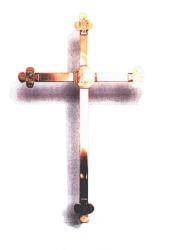
|
|
|
|
The conversion of the mosque, which had been India Lines, was carried out by Edward Wincott R.E.s, who started the pulpit and altar rails. The plaque of St. George and the Dragon was made by Robert Payne and Harry Ralph, also R.Es. A Pair of candlesticks were lovingly looked after by Cpl. Sid Roper, R.A.O.C., who brought them home and they are now in the Imperial War Museum. This was also the first home of a beautifully made brass cross.
This cross was known by many ex-Far East prisoners as "The Changi Cross", it came into being shortly after the fall of Singapore. Under the guidance of Capt. Akester, of the 18th Division Ordnance Workshops, and with the help of the experts, an engineering workshop was built up from material scrounged from the surrounding area.
The cross itself was made by a Staff Sergeant of the R.A.O.C. unfortunately only his first name, 'Harry', is remembered. The base of the cross was fashioned from the base of a 4.5 howitzer shell, the rest from carefully fashioned strips of brass. At each of the four ends it carried trefoils engraved with facsimiles of the cap badges of 'Royal Army Ordinance Corps', 'Royal Engineers', 'Royal Northumberland Fusiliers' and the 'Royal Army Service Corps'. The base was engraved with the badge of the 'Royal Artillery'. At a later date the wording 'St. George's Church and 'Prisoner of War Camp 1942-1945 was added to the base. These engravings were carried out by Tim Herrings, Royal Engineers.
The church was closed when "F" Force was sent up country. Padre Cordingly took with him the alter cross and the plaque of St. George to Bampong along with other ornaments. The Bishop, as he was affectionately known, re-established St. George's Church (Mark 111) in 'Kamburi'.
Eventually the Cross and plaque were brought home by Padre Cordingly, then in 1992, on Mrs Cordingly's suggestion, the cross was returned to Singapore where it was handed over to the Rev. Henry Khoo at the Memorial Chapel. On permanent loan from the Cordingly family the Cross has been mounted in a Perspex fronted box and fixed to the rear of the alter. There is no doubt it adds a great deal to the feeling within the Memorial Chapel in Changi, which is a virtual replica of the original.
The Cross will continue to remind us of all who helped others, those unfortunate and wonderful comrades who did not return home, and those who, after their return, suffered and untimely death.
Taken from a story by Bill Holtham
|
|
|
|
It has now been confirmed that the Changi Cross was built by
|
|
Staff Sergeant Harry Stogden of the RAOC
|
|
Please click on his name to read his story
|
|
|
|

|
|
|
|
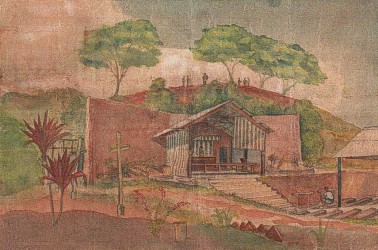
|
|
Changi Chapel
|
|
By Desmond Bettany (1943)
|
|
|
|
A small open air chapel was built by the prisoners of war during their imprisonment and became a great comfort to the many who prayed there.
|
|
|
|
|
|
The Roman Catholic Chapel, Selarang
Changi Photographer By George Aspinall
This little chapel was built by the POW’s, supervised by the Padres. The alter end was under cover and the seats were out in the open. The pictures on the wall were painted by some of the men.
|
|
|
|
The original chapel was moved after the war by the Australians, reconstructed and now stands in the grounds of Duntroon Royal Military College.
|
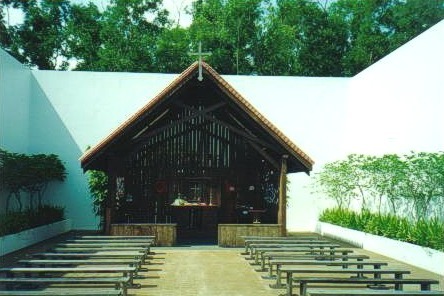
|
|
Replica Chapel
|
|
Supplied by Janet Jacobs
|
|
A replica was built outside Changi Prison in Singapore, but the original Changi Cross still remained in this simple chapel. Work commenced to extend the prison itself and the chapel and its adjacent museum and was moved to a site on the Upper Changi Road North, just one kilometre away from the prison. This is considered a quiet and tranquil area in keeping with a place of peace and worship. It is expected to open some time during the summer.
See - Changi Chapel and Museum and also Singapore American
|
|
|
|
|
|

